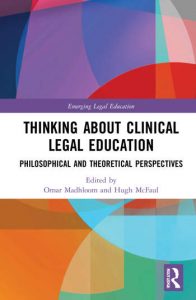by Omar Madhloom and Hugh McFaul
In a recent article, one of the authors of this blog posed the question whether Clinical Legal Education (CLE) requires theory. In an effort to address this question, we invited academics and law clinic directors from various jurisdictions such as Brazil, Canada, England, Ethiopia, Israel, and the United States to consider the theories that underpin their CLE programmes. This resulted in an edited collection entitled Thinking About Clinical Legal Education: Philosophical and Theoretical Perspectives. The intention of this volume is not to obscure or eclipse the practical and experiential by focusing on theory, but to invite the reader to consider whether the practice of CLE can be enhanced by paying more explicit attention to its theoretical underpinnings.
This volume provides a range of philosophical and theoretical frameworks that can serve to enrich the teaching and practice of CLE, which has become an increasingly common feature of the curriculum in law schools across the globe and which provides an alternative to the dominant doctrinal method. One of the findings in this volume is the prevalence of the positivist approach in legal education, which gives students the false impression that law is autonomous and disconnected from wider social forces. Consequently, in the words of one commentator, lawyers are not trained to reflect on ‘the emergence and stabilization of the complex institutions that lawyering silently presupposes’. The contributors to this collection aim to enhance law students’ reflection by providing educators and students with different methods of addressing the complexities and uncertainties encountered in legal practice. In addition to theories such as therapeutic jurisprudence and Rawls’ theory of distributive justice, the volume includes a chapter which draws insights from the work of French sociologist, Pierre Bourdieu, to consider the extent to which CLE can function as an engine of social justice and mobility for students through the development of their social and cultural capital.
The chapters in this collection demonstrate that CLE encompasses a varied and vibrant approach to legal education which, given its focus on the practical and experiential, often operates on the fringes of the mainstream university law curriculum. The various chapters that demonstrate that insights derived from applying theoretical and philosophical approaches to CLE provide new pathways for a reflective, critical, and socially engaged approach to legal education. In this way the chapters resonate with the origins of the CLE movement, which are routinely traced to Jerome Frank’s 1933 paper ‘Why Not a Clinical Lawyer- School’ where Frank used his own theoretical insights to argue for a more socially engaged approach to the teaching of law, an approach that would challenge the dominance of the case method then used throughout law schools in USA.
In producing this book, it is not our intention to promote or prioritise one particular theoretical position to the exclusion of another; rather it is to invite and encourage readers to draw on the insights and ideas offered by the various theoretical positions presented in this volume and think about how they can be applied to their own CLE programme. In this way, we hope the volume will have succeeded in its core aim of having an illuminating and energising effect on CLE practice.

